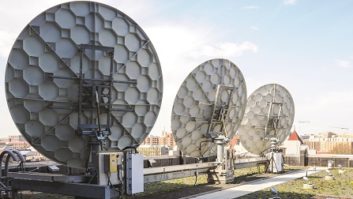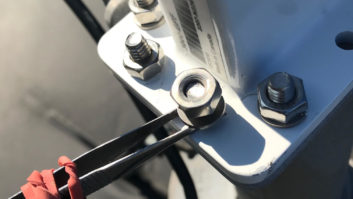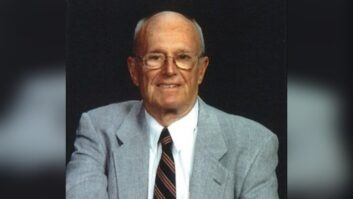
Seems like everyone has been floating a proposal on what the FCC should do with the C-band. Plans from competing groups in Washington have generated buzz in broadcast circles, and even members of Congress recently released some details of their own compromise proposals for the spectrum.
At this point it seems certain that the FCC will transfer some or all of the 500 MHz spectrum of the C-band to wireless companies for new terrestrial 5G networks, in some manner. Experts say radio broadcasters who receive programming via satellite earth-stations could face disruptions and financial ramifications of a massive C-band migration caused by a repack.
The value of the band — and we are finding out just how valuable it is — is drawing lots of attention from broadband companies who want to see the repurposing of the spectrum (3.7–4.2 GHz) for 5G use. Other groups including the National Association of Broadcasters, National Public Radio and the Society of Broadcast Engineers, want to avoid a spectrum crunch; they regard the spectrum as essential for broadcasters and the fixed satellite service licenses using the 500 MHz for distribution of programming.
Some of the stakeholders told Radio World in July that the interest groups involved are trying to find what one called “a mutually acceptable landing spot for the spectrum shakeup.”
BIG AUCTION COMING
The FCC will ultimately resolve the 5G mid-band state of affairs, observers said, with a Report and Order expected later in 2019.
The commission’s options include splitting up the C-band spectrum or mandating the sharing of the same spectrum by both commercial wireless and fixed satellite users. The latter is something NAB and NPR oppose.
Ideally, the FCC could just pick the proposal with the most stakeholder support behind it, but none of the competing proposals has gained universal support from wireless carriers or broadcasters, said one industry insider.
One thing that is clear to observers is that the 5G FAST plan spearheaded by FCC Chairman Ajit Pai is moving forward.
The 5G FAST plan includes three central components: freeing up much more spectrum for the commercial marketplace, promoting wireless infrastructure deployment and modernizing regulations to promote more fiber deployment, according to Pai.
The commission in June voted to modernize the legacy regulatory framework for the 2.5 GHz band to make it available for advanced wireless services, including 5G. It’s not clear how that move could impact the C-band decision, industry observers said.
In addition, the FCC intends to start its third 5G spectrum auction in December 2019. It will be the largest spectrum auction in the nation’s history, according to the FCC, with 3,400 megahertz in three bands to be auctioned.
BROADCAST VOICES
NAB says it is playing a constructive role in the FCC’s C-band rulemaking process, according to Patrick McFadden, associate general counsel for NAB.
“More than a hundred million American households depend on the C-band spectrum for news and entertainment they enjoy every day. As the FCC weighs options for reallocating a portion of the C-band, NAB is committed to working with the commission and other stakeholders to protect viewers and listeners from disruption or loss of service,” McFadden said.
There are more than 16,000 registered receive-only dishes in the field, according to NAB, being used to receive national and syndicated programming for TV and radio.
NAB has asked the FCC to take a cautious approach into wireless expansion of the band and continues to press for a realistic resolution.
“Small missteps in this proceeding will have dramatic ramifications that threaten the stability and reliability of the infrastructure that distributes content American viewers and listeners enjoy, and in which programmers invest billions of dollars every year,” it wrote the FCC in an early filing.
The C-band Alliance, led by Intelset, SES and Intel, has proposed to split the band frequency, with 200 MHz for 5G and reserving 300 MHz for the broadcast community’s C-band dishes near the top of the range. Observers said the plan keeps 5G away from aeronautical mobile folks above 4.2 GHz.
The CBA’s proposed approach would clear 200 MHz of the C-band in 18 to 36 months for terrestrial 5G use via a market-based mechanism.
[With Earth Station Filing Deadline Set, FCC Will Eye Potential C Band Opportunities]
The commission has asked for comment on auction-based and market-based proposals, according to FCC filings.
“There are some very compelling parts to it,” said one person familiar with the alliance proposal. “This is what (the alliance) are expert in, so I would imagine it will carry weight at the commission.”
In addition, the alliance has established a schedule of “transition-related expenses” that satellite operators would reimburse customers, including broadcasters, for repacking expenses — if the FCC accepts its plan.
NAB asked the FCC in an early filing to ensure that “costs for implementing such a plan should be entirely borne by the beneficiaries of any private or public spectrum transaction: either the satellite operators or the mobile carriers who acquire spectrum usage rights.”
PUBLIC RADIO CONCERNS
National Public Radio also is pressing the FCC for clarity in its final decision when it comes to the financial ramifications of a massive C-band migration of satellite earth-stations caused by a repack.
NPR has a lot riding on the FCC’s decision, according to public radio officials, since the Public Radio Satellite System (PRSS) depends on C-band for distribution of programming to approximately 1,278 public radio stations, said Adam Shoemaker, counsel for NPR, in an FCC filing.
“We’ve been very active at the FCC and seen every one of the commission staff and most of the commissioners,” said Mike Riksen, VP for policy and representation for NPR.
“We’ve also been very active on Capitol Hill with members of Congress. We want to make sure the policymakers who will make decisions on this are aware of our heavy reliance on the C-band.”
The public broadcaster is supportive of the Intelset approach, Riksen said, and the “continued access to C-band frequencies that are affordable to us in the public broadcasting world.”
NPR prefers a “division of spectrum” with designated spectrum for incumbent and commercial wireless users rather than mandating the sharing of the same spectrum, Riksen said.
“(NPR) has some basic requirements. We need access to C-band frequencies at affordable rates and we need it for reliable service,” Riksen said.
The FCC began vetting the idea of repurposing the C-band in July 2018 with a notice of proposed rulemaking. The commission earlier this summer asked for additional comments on several questions, including protection criteria for licensed or registered receive-only earth station operators against co-primary terrestrial operations; and how to accommodate licensed or registered earth station operators that are displaced as a result of repurposing the C-band.
[SBE Puts Forth C-Band Alternative]
Some experts told Radio World they see the FCC eventually splitting the band evenly 250/250 MHz each with most stakeholders willing to accept some frequency division. However some of the big commercial wireless carriers, like T-Mobile, still believe they have the horsepower to carry this through and gain more spectrum.
T-Mobile has gone so far as to recommend that all satellite downlink sites be replaced by fiber, something NAB and NPR and other broadcast groups call “completely unacceptable.”
“It’s become quite obvious that the FCC has no intention other than accommodating 5G since there is fear this country is already behind Europe and Japan in 5G rollout,” said Chris Imlay, SBE general counsel.
POLITICS
And the fight for spectrum for next-gen broadband and wireless services has taken a political turn, according to industry insiders.
To be determined is whether the commission ultimately chooses to reallocate some portion of the C-band through a private arrangement, a government-administered auction or some other mechanism.
Rep. Mike Doyle (D-Pa.), chair of the House Energy and Commerce Subcommittee on Communications and Technology, earlier this year blasted the C-band Alliance proposal, which, if conducted as a private sale, would be worth billions of dollars to the consortium, he said.
It’s “irresponsible and unconscionable” for the FCC to give money to satellite companies when “the broadband needs of our country are so great,” Doyle said at a May subcommittee meeting, as quoted in media reports.
Doyle, who said he has seen some accounts that place the value of the C-band as high as $70 billion, wants the money to go to 5G deployment in this country.
More recently, Rep. Doris Matsui (D-Ca.) vice chair of the same committee Doyle oversees, proposed a compromise to repurpose the C-band. Her plan, called the “WIN 5G Act,” would use a “consensus-based, compromise approach to reallocate” the spectrum.
NPR asked the FCC in July that “receive-only earth stations be allowed to participate in any reverse auction or other reallocation procedure that would affect their existing use of C-band spectrum,” according to its filing.
Since Congress makes laws and an agency like the FCC implements them, NPR’s Riksen said, the FCC must ultimately follow the lead of Congress.
“The FCC can make policy only through regulatory action. It has no statutory authority to do so,” Riksen said.
[Senators Urge FCC to Be Mindful of C Band Incumbents]
Wireless groups, like the Competitive Carriers Association, ACA Connects: America’s Communications Association and Charter Communications, have proposed an even larger chunk of C-band’s 500 megahertz be reallocated for wireless than what the C-band Alliance would create. CCA proposes 370 MHZ or more for 5G and broadband development.
In addition, the FCC is still considering the flexible use of parts of C-band spectrum. The sharing of the 3.7 GHz to 4.2 GHz band between satellite earth-stations and point-to-multipoint (P2MP) systems remains a possibility, experts say.
The Wireless Internet Service Providers Association along with Google and Microsoft have presented the FCC a plan and submitted research that shows the two services can co-exist on the same frequencies. The companies want to development of broadband service to rural parts of the country over fixed wireless access points, according to published accounts.
You can read comments on the proposed C-band repurposing by going through the FCC ECFS database using Docket 18-122.












